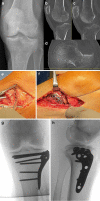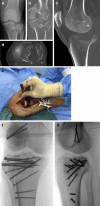The concept of direct approach to lateral tibial plateau fractures and stepwise extension as needed
- PMID: 32607776
- PMCID: PMC7691307
- DOI: 10.1007/s00068-020-01422-0
The concept of direct approach to lateral tibial plateau fractures and stepwise extension as needed
Abstract
Malreduction after tibial plateau fractures mainly occurs due to insufficient visualization of the articular surface. In 85% of all C-type fractures an involvement of the posterolateral-central segment is observed, which is the main region of malreduction. The choice of the approach is determined (1) by the articular area which needs to be visualized and (2) the positioning of the fixation material. For simple lateral plateau fractures without involvement of the posterolateral-central segment an anterolateral standard approach in supine position with a lateral plating is the treatment of choice in most cases. For complex fractures the surgeon has to consider, that the articular surface of the lateral plateau only can be completely visualized by extended approaches in supine, lateral and prone position. Anterolateral and lateral plating can also be performed in supine, lateral and prone position. A direct fixation of the posterolateral-central segment by a plate or a screw from posterior can be only achieved in prone or lateral position, not supine. The posterolateral approach includes the use of two windows for direct visualization of the fracture. If visualization is insufficient the approach can be extended by lateral epicondylar osteotomy which allows exposure of at least 83% of the lateral articular surface. Additional central subluxation of the lateral meniscus allows to expose almost 100% of the articular surface. The concept of stepwise extension of the approach is helpful and should be individually performed as needed to achieve anatomic reduction and stable fixation of tibial plateau fractures.
Keywords: Anatomic reduction; Osteosynthesis; Posterolateral corner; Surgical approach; Tibial plateau fracture.
Conflict of interest statement
KH Frosch received royalties and fees for presentations from Arthrex. All other authors have no conflicts of interest.
Figures




Similar articles
-
Surgical Treatment of Lateral Tibial Plateau Fractures Involving the Posterolateral Column.Orthop Surg. 2019 Dec;11(6):1029-1038. doi: 10.1111/os.12544. Epub 2019 Nov 6. Orthop Surg. 2019. PMID: 31693310 Free PMC article.
-
Extended Anterolateral Approach for Complex Lateral Tibial Plateau Fractures.J Knee Surg. 2017 Mar;30(3):204-211. doi: 10.1055/s-0037-1598077. Epub 2017 Feb 24. J Knee Surg. 2017. PMID: 28235235
-
The anterolateral supra-fibular-head approach for plating posterolateral tibial plateau fractures: A novel surgical technique.Injury. 2016 Feb;47(2):502-7. doi: 10.1016/j.injury.2015.11.010. Epub 2015 Nov 22. Injury. 2016. PMID: 26684172
-
[Osteosynthesis of bicondylar tibial plateau fracture in a prone position : Video article].Unfallchirurg. 2018 Dec;121(12):1004-1010. doi: 10.1007/s00113-018-0574-8. Unfallchirurg. 2018. PMID: 30402690 Review. German.
-
Approaches and fixation of the posterolateral fracture fragment in tibial plateau fractures: a review with an emphasis on rim plating via modified anterolateral approach.Int Orthop. 2017 Sep;41(9):1887-1897. doi: 10.1007/s00264-017-3563-6. Epub 2017 Jul 22. Int Orthop. 2017. PMID: 28735430 Review.
Cited by
-
Outcomes of Anterior Lateral Approach and Gerdy's Tubercle Osteotomy for Tibial Plateau Fractures Involving the Posterior Lateral Condyle: A Retrospective Study of 20 Patients.Med Sci Monit. 2024 Jun 18;30:e943946. doi: 10.12659/MSM.943946. Med Sci Monit. 2024. PMID: 38887008 Free PMC article.
-
Location of lateral tibial plateau fractures relative to the posterolateral complex predicts the need for extension of lateral approaches: A retrospective observational study.Eur J Trauma Emerg Surg. 2025 Jul 21;51(1):257. doi: 10.1007/s00068-025-02933-4. Eur J Trauma Emerg Surg. 2025. PMID: 40691664 Free PMC article.
-
Lack of standardisation in the management of complex tibial plateau fractures: a multicentre experience.Eur J Trauma Emerg Surg. 2024 Dec;50(6):2937-2945. doi: 10.1007/s00068-024-02616-6. Epub 2024 Aug 2. Eur J Trauma Emerg Surg. 2024. PMID: 39095621 Free PMC article.
-
Lateral epicondyle osteotomy results in improved radiologic and functional outcomes in severe lateral tibial plateau fractures: a retrospective cohort study.J Orthop Surg Res. 2025 Apr 10;20(1):363. doi: 10.1186/s13018-025-05775-3. J Orthop Surg Res. 2025. PMID: 40211388 Free PMC article.
-
Letter to the editor of: "posterior tibial plateau impaction fractures are not associated with increased knee instability: a quantitative pivot shift analysis".Knee Surg Sports Traumatol Arthrosc. 2023 Aug;31(8):3572-3575. doi: 10.1007/s00167-023-07361-8. Epub 2023 Mar 22. Knee Surg Sports Traumatol Arthrosc. 2023. PMID: 36947235 Free PMC article. No abstract available.
References
-
- Parkkinen M, Madanat R, Mustonen A, Koskinen S, Paavola M, Lindahl J. Factors predicting the development of early osteoarthritis following lateral tibial plateau fractures: mid-term clinical and radiographic outcomes of 73 operatively treated patients. Scand J Surg. 2014;103(4):256–262. doi: 10.1177/1457496914520854. - DOI - PubMed
-
- Honkonen SE. Indications for surgical treatment of tibial condyle fractures. Clin Orthop Relat Res. 1994;302:199–205. - PubMed
Publication types
MeSH terms
LinkOut - more resources
Full Text Sources
Medical

